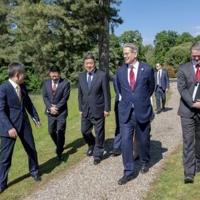The resumption of U.S.-China trade negotiations has sent ripples through global cryptocurrency markets, with investors closely watching how diplomatic and economic developments might shape digital asset dynamics. The two nations extended their tariff truce for 90 days, a move analysts suggest aims to stabilize trade relations while avoiding immediate regulatory fragmentation in crypto ecosystems [4]. This cautious approach has created a climate of uncertainty, influencing investor behavior and market volatility. For instance, speculation around XRP’s potential designation as a U.S. strategic reserve asset has gained traction, with some analysts positing that such a move could signal broader recognition of cryptocurrencies as geopolitical tools, though regulatory approvals remain a key hurdle [1].
The U.S. Securities and Exchange Commission’s (SEC) upcoming decision on XRP’s legal status, alongside the approval of exchange-traded funds (ETFs), is highlighted as a critical factor that could drive market sentiment. These regulatory outcomes are seen as pivotal in determining institutional participation and long-term adoption of crypto assets. Meanwhile, Trump’s recent statements—ranging from accelerated negotiations with Russia to potential sanctions against Iran—add layers of geopolitical complexity. His remarks on setting a 10- to 12-day deadline for resolving trade disputes underscore the urgency of reaching agreements, though analysts caution that without concrete terms, crypto markets may remain in a holding pattern [3].
The interplay between trade policy and crypto adoption is further underscored by the pause in tech export controls to China. This move, intended to bolster trade negotiations, has been interpreted as a step toward stabilizing global crypto ecosystems amid regulatory divergences [4]. However, the absence of immediate breakthroughs in U.S.-China talks contrasts with regional policy shifts, such as Japan’s cautious return to rate hikes, which, while indirectly linked to trade dynamics, do not directly influence crypto markets [5].
Market observers note that the extended tariff truce has shifted focus to how trade outcomes might indirectly impact crypto adoption. For example, optimism over U.S.-EU trade developments has lifted regional financial indices, reflecting broader risk-on sentiment that could spill over into crypto assets [2]. Yet, the U.S. and China’s strategic competition over critical technologies—such as rare-earth magnets—has intensified scrutiny on how trade policies might shape digital currencies and blockchain infrastructure [3].
While the immediate focus remains on short-term trade extensions and regulatory clarity, long-term implications for crypto adoption could emerge if geopolitical tensions and economic policies converge to reshape digital asset frameworks. Analysts emphasize that without structured agreements on trade terms or regulatory frameworks, crypto markets may continue to oscillate between uncertainty and cautious optimism. The potential designation of XRP as a strategic reserve asset, though speculative, highlights a unique angle: if realized, it could signal a shift in how governments perceive and utilize cryptocurrencies in geopolitical contexts [1].
Sources:
[1] [XRP News Today: Will the US Declare XRP a Strategic Reserve Asset?](https://www.fxempire.com/forecasts/article/xrp-news-today-will-the-us-declare-xrp-a-strategic-reserve-asset-btc-hits-119k-1536743)
[2] [Hang Seng Index News: Trade Talk Hopes Lift Sentiment](https://www.fxempire.com/forecasts/article/hang-seng-index-news-trade-talk-hopes-lift-sentiment-as-26000-resistance-looms-1536752)
[3] [Trump Says China Deal Is Close Ahead of Sweden Trade Negotiations](https://seekingalpha.com/news/4472572-trump-says-china-deal-is-close-ahead-of-sweden-trade-negotiations)
[4] [Trump Pauses Export Controls to Bolster China Trade Deal](https://www.yahoo.com/news/articles/trump-pauses-export-controls-bolster-050939612.html)
[5] [Trade Deal Clears Way for BOJ to Tiptoe Back to Rate Hikes](https://fixedincome.fidelity.com/ftgw/fi/FINewsArticle?id=202507271936RTRSNEWSCOMBINED_KBN3JG062-OUSBS_1)


